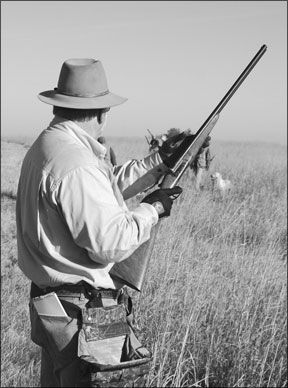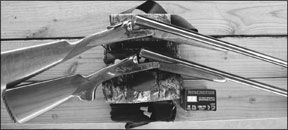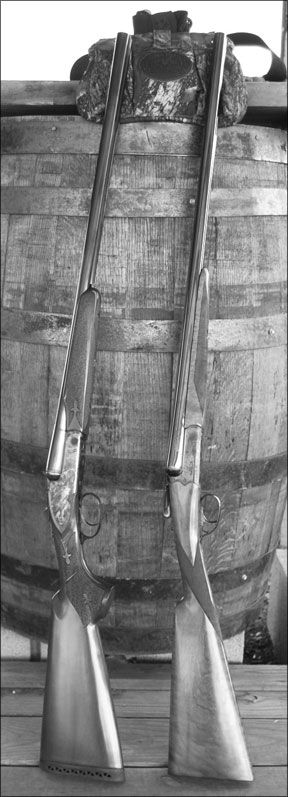At one time, the shotgun that was the must-have tool for many a bird hunter was a finely crafted side-by-side. Fixed chokes, lots of drop in the stock with the resulting hefty recoil from all but the lightest loads, and a wide view down the barrels were what serious wingshooters had to accept.
Times have changed, and the “double barrel” has fallen out of favor in most shooting circles. Semiautomatics and over and unders dominate most scattergun venues, with their owners citing less recoil, smoother handling and more availability among the reasons for their selection of more modern shooting tools.
However, like the little engine that could, the side-by-sides still chug along in a limited market and are sought out by shooters with a little sense of history in their souls.

Two new entries into this select category of shooters are the Smith & Wesson Elite Gold Grade I 20 gauge side-by-side and the L.C. Smith 20 gauge side-by-side now distributed by Marlin. While the S&W version is designed with the more traditional English double styling and the L.C. Smith is a reproduction of the working tool models of American doubles, both offer a taste of the old days.
Each shotgun has its pluses and minuses, and the S&W version carries a price tag that is a little more than $400 over the L.C. Smith. Finer wood, better case hardening and a slimmer, trimmer balance add to the price of the S&W.
How We Tested
Although both shotguns will handle 3-inch shells, we limited our test ammunition to 2.75-inch loads to satisfy some of the recoil-challenged members of our test team.
Our ammunition selection for this test included Winchester Super Sport Sporting Clays 2.75-inch loads with a 2.5 dram equivalent, seven-eighth ounce of No. 7.5 shot and a muzzle velocity of 1,300 fps; and Estate Cartridge Super Sport Competition Target 2.75-inch loads with 2.5 dram equivalent, seven-eighth ounce of No. 7.5 lead shot with a muzzle velocity of 1,200 fps. There were no malfunctions of any kind with any of the shells, but the patterning performance with the different ammunition was surprising.
The L.C. Smith did not perform well with the Estate ammunition, producing a 70-30 (more hits below the center than above) pattern with the right barrel and a 90-10 pattern with the left barrel. Patterns with the Winchester ammunition in both barrels were consistently 70-30, which although they were lower than we would have liked, would be acceptable.
Patterns with both types of ammunition in the S&W were 60-40 through both barrels-a more preferred performance favored by most shooters and receiving good marks by our team. Here are the full details about each gun:
Smith & Wesson Elite
Gold Grade I 20 Gauge, $2380
Introduced into the field gun market in January 2007, this gun had 26-inch barrels and an overall length of 43.5 inches. The length of

pull on the stock, which featured a checkered butt rather than a recoil pad or butt plate, was 14.6 inches, and the gun weighed 6.5 pounds.
Our shooters said the shotgun was quick and smooth into each target. There were no problems mounting the gun into shooting position, but we would have preferred a pad or plate to prevent slippage. This could be accomplished by a short trip to a nearby gunsmith if the S&W owner prefers practicality over classic appearance.
The drop at the comb of 1.5 inches and a drop at the heel of 2.25 inches were within the acceptable range and provided a good sight picture down the solid rib. We noted that there is both a mid-bead and a white front bead on the rib-a feature that we consider to be on the plus side of the tally sheet.
Both the S&W and the L.C. Smith models did not offer a barrel selector, so the right barrel always fired first. Not a major problem, even with the S&Ws fixed chokes of improved cylinder and modified, but worth noting.
We found that the trigger pull on the right barrel of the S&W was 6 pounds, while the left barrel touched off at 6.25 pounds. Both were crisp and clean touch offs.
We also liked the way the S&W ejected shells up and out of the chambers with a smooth, solid stroke. Side-by-side shotguns, because of their design, can be loaded and unloaded quicker than their over-and-under counterparts. That is just one more factor we enjoyed when handling this shotgun.
Because of the wider sight picture down the barrels, there was a little adjustment required in shooting birds and targets with both the test guns. After relearning how to shoot a double barrel, our target hits were solid and convincing with the S&W.
Factoring in the quality appearance and smooth handling ability of the S&W, we have no problem in recommending this firearm for shooters interested in a trip down memory lane.
L.C. Smith Side-by-Side
20 gauge, $1962

This gun, distributed by Marlin, provides a more standard shooting tool used by early-American wing-shooters than the classic double barrel models made in England in the old days.
We noted when the shotgun came out of the box that the wood in the stock lacked the grain and fine appearance of the S&W. While some shooters might not be concerned about “pretty,” we felt that straight-grained, dark wood of the pistol-grip stock and beaver-tail forearm were a little bump in our road to the past.
Unlike the S&W, the L.C. Smith featured screw-in chokes, which is a big plus for those shooters who like to adjust their pattern to different shooting situations. We would have preferred that the chokes were better marked (cuts in the end of the choke identified the constriction, rather than any writing on the choke).
After checking the manual, we found that the choke tubes supplied with our test gun were improved cylinder, modified and full.
The overall length of the L.C. Smith with 26-inch barrels was 43 inches, with weight of 6.1 pounds and a length of pull of 14.25 inches. The shotgun featured a rubber recoil pad, which served its purpose of reducing felt recoil and helped shooters hold the stock into place in their shoulder.
Drop at the comb was 1.5 inches and drop at the heel was 2.5 inches. No problems there. We did encounter some problems with the function of the shotgun. About every other time that the action was opened and closed, the top lever failed to return to the center position and had to be pushed into the locked position.
Although the force required to return the lever into the locked position was slight, it should not have been necessary. We would recommend that if the purchaser experiences a similar problem with the lever, a trip to a gunsmith would be prudent.
We found the feel and handling ability of the L.C. Smith to be good, but not as smooth as the slimmer and trimmer S&W. Some shooters may favor the beaver-tail forearm and bulkier pistol grip stock, and that is their personal choice. We simply liked the feel of the S&W over the L.C. Smith.
Spent shells were ejected with authority from the chambers of this little side-by-side and, as noted earlier, the double barrel was quick and easy to load and unload.
Because of the patterning performance of the L.C. Smith as noted above, second shots at targets were normally off the mark. Once again, a gunsmith adjustment might be necessary if a purchaser finds his second barrel producing low hits.
We were also very dissatisfied with the trigger pulls on the L.C. Smith, which fired the right barrel at 7 pounds and the left barrel at 10 pounds. While field conditions might allow for such hefty tugs, any time at a clays course would become quite a chore and target-breaking results could be affected.
Smith-Wesson-Elite-Shotgun-0108.pdf

























